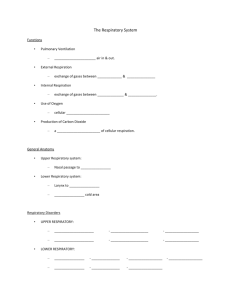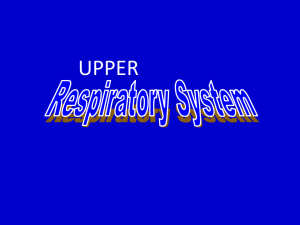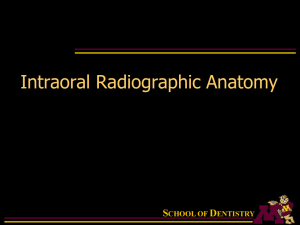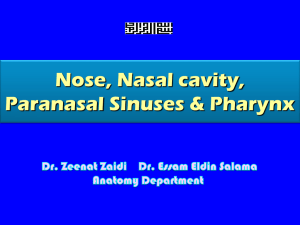Articulation 6 — resonating chambers (cavities)
advertisement
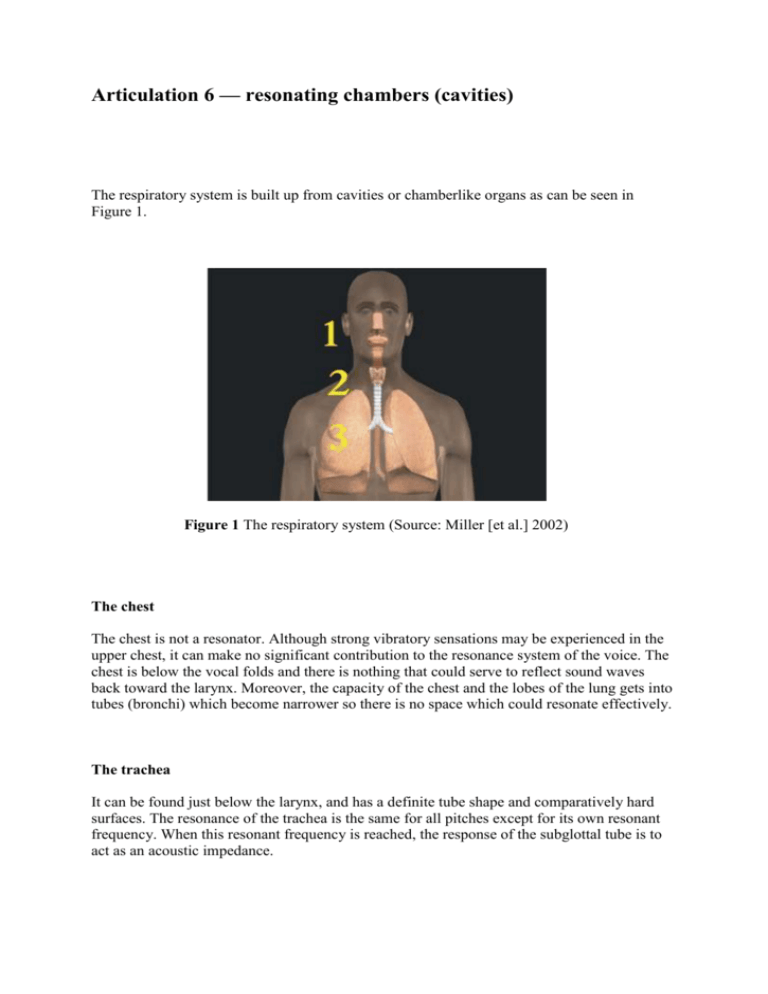
Articulation 6 — resonating chambers (cavities) The respiratory system is built up from cavities or chamberlike organs as can be seen in Figure 1. Figure 1 The respiratory system (Source: Miller [et al.] 2002) The chest The chest is not a resonator. Although strong vibratory sensations may be experienced in the upper chest, it can make no significant contribution to the resonance system of the voice. The chest is below the vocal folds and there is nothing that could serve to reflect sound waves back toward the larynx. Moreover, the capacity of the chest and the lobes of the lung gets into tubes (bronchi) which become narrower so there is no space which could resonate effectively. The trachea It can be found just below the larynx, and has a definite tube shape and comparatively hard surfaces. The resonance of the trachea is the same for all pitches except for its own resonant frequency. When this resonant frequency is reached, the response of the subglottal tube is to act as an acoustic impedance. Let’s see the oral tract between the trachea and the orifice encircled by the two lips. Nasal cavity Oral cavity Figure 2 Chambers of the oral tract (Based on Benda 2013) The larynx This boxlike organ is the active source of resonance. It includes the vocal cords, which can vibrate. (Voiced sounds are articulated.) If they do not vibrate, within the vocal tract it is not an occlusion which could cause a noise. (Voiceless consonants are pronounced. There are two exceptions, namely the sound /h/ and the glottal stop /ʔ/. They are articulated in the larynx.) The pharynx It is a rather passive tube while speech sounds either in English or in Hungarian are articulated. Nevertheless, its volume is pretty large in comparison to other cavities in the head as can be seen in Figure 2. Thus it has a vital part of producing resonance and/or pitch. The oral cavity It is a chamber which takes extremely active part in articulating speech sounds. The nasal cavity This living cave is involved in very different functions: 1 As regards respiration, it cleans and heats the inhaled air. 2 As regards perception, it is the organ of olfaction i.e. the sense of smell. 3 As regards pronunciation, if the air is diverted by the uvula into the nasal cavity, nasal consonants or nasalised vowels are articulated. Depending in the position of the uvula, the nasal and oral cavity may resonate individually or in combination. The features a sound may have are: oral, nasal and nasalised. (Nasal sounds are produced by lowering the velum and allowing air to pass through the nasal passages.) Figure 3 Oral articulation (Based on ‘Sound production’) Figure 4 Nasal articulation (Based on ‘Sound production’) Nasalised articulation Figure 5 The directions of airstream during the articulation of nasalised vowels (Source: ‘Sound production’) Paranasal sinuses /ˌpærəˈneɪzᵊl ˈsaɪnəsɪz/ These are ‘mucosa-lined air cavities in bones of the skull, communicating with the nasal cavity and including ethmoidal, frontal, maxillary, and sphenoidal sinuses.’ (Source:‘Sinus’) (A sinus /ˈsaɪnəs/ is a cavity or recess in a bone.) Their articulatory function is to modify voice and this way human sound becomes very personal and distinguishable/recognisable. Figure 6 Paranasal sinuses (Source: ‘Sinus’) /ˌpærəˈneɪzᵊl ˈsaɪnəsɪz/ Sources: Benda 2013 Benda, J. Thomas. ‘Hypopharynx.’ In: Healthtap. <https://www.healthtap.com/user_questions/256513what-region-of-the-pharynx-is-closest-to-the-larynx> Uploaded: 2013 Retrieved: 20-08-2013 Miller [et al.] 2002 Miller, Dave [et al.]. ‘The origin of language and communication.’ In: Apologetics press. <http://www.apologeticspress.org/apcontent.aspx?category=9&article=1351> Uploaded: 2002 Retrieved: 21-08-2013 ‘Sinus.’ [s. a.] ‘Sinus.’ [Dictionary entry.] In: The free dictionary : medical dictionary. <http://medicaldictionary.thefreedictionary.com/sinus> Uploaded: [s. a.] Retrieved: 21-08-2013 Cited from Dorland's Medical Dictionary for Health Consumers. © 2007 by Saunders, an imprint of Elsevier, Inc. ‘Sound production’ [s. a.] ‘Sound production.’ In: Introduction to phonetics. <http://www.unil.ch/ling/page24434.html> Uploaded: [s. a.] Retrieved: 21-08-2013



